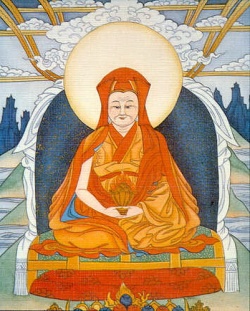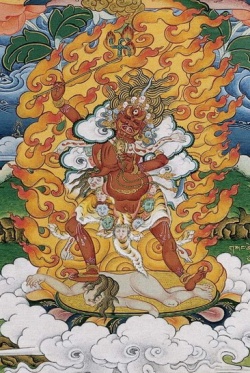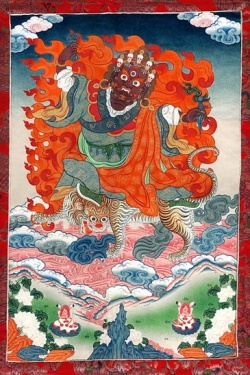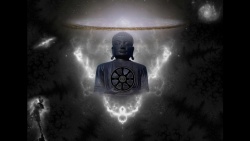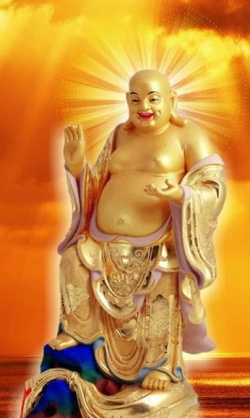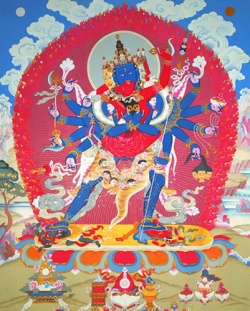Difference between revisions of "Ariyas (Noble Persons)"
(Created page with "<poem> There are eight types of ariyas — namely, four magattha-persons and four phalattha-persons. The maggattha-persons, however, exist only for a conscious moment each, ...") |
|||
| (6 intermediate revisions by 2 users not shown) | |||
| Line 1: | Line 1: | ||
| − | <poem> | + | <poem> |
| − | + | [[File:Gampopa34.jpg|thumb|250px|]] | |
| − | |||
| − | |||
| − | |||
| − | Again an anagami may undertake vipassana meditation, and when he attains the fourth magga, he becomes an arahatta-maggattha person. But as soon as the arahatta-magga citta dissolves, arahatta-phala citta arises and he becomes an arahatta-phalattha person or arahat from that moment onwards. | + | |
| + | There are eight types of [[ariyas]] — namely, four magattha-persons and four phalattha-persons. The maggattha-persons, however, [[exist]] only for a [[conscious]] [[moment]] each, i.e., during the [[magga-citta]] they are experiencing. After the [[dissolution]] of the [[magga-citta]], they become phalattha-persons. | ||
| + | [[File:0606.jpg|thumb|250px|]] | ||
| + | |||
| + | For example, a [[person]] is called a [[sotapatti]] [[maggattha]] [[person]] while the [[sotapatti-magga]] [[citta]] is [[arising]] in him. After the [[dissolution]] of this [[citta]], [[sotapatti-phala]] [[citta]] arises in him and he is known as a sotapatti-phalattha [[person]] or [[sotapanna]] from this [[moment]] onwards. | ||
| + | [[File:Ekajati 40.jpg|thumb|250px|]] | ||
| + | |||
| + | If a [[sotapanna]] again undertakes [[vipassana]] [[meditation]], he will attain [[sakadagami-magga]] in due course. During this second [[magga-citta]], he is called a sakadagami-maggattha [[person]]. After the [[dissolution]] of this [[citta]], [[sakadagami-phala]] [[citta]] arises in him and he is known as a sakadagami-phlattha [[person]] or [[sakadagami]] from this [[moment]] onwards. | ||
| + | [[File:Dorje trollo 4jpg.jpg|thumb|250px|]] | ||
| + | |||
| + | A [[sakadagami]] may again undertake [[vipassana]] [[meditation]]. When he attains the third [[magga]], he is known as an anagami-maggattha [[person]] while that [[magga-citta]] lasts. As soon as the [[magga-citta]] dissolves, [[anagami-phala]] [[citta]] arises in him and he is called an anagami-phalattha [[person]] or [[anagami]] from that [[moment]] onwards. | ||
| + | [[File:DharmaChakra414.jpg|thumb|250px|]] | ||
| + | |||
| + | Again an [[anagami]] may undertake [[vipassana]] [[meditation]], and when he attains [[the fourth]] [[magga]], he becomes an arahatta-maggattha [[person]]. But as soon as the [[arahatta-magga]] [[citta]] dissolves, [[arahatta-phala]] [[citta]] arises and he becomes an arahatta-phalattha [[person]] or [[arahat]] from that [[moment]] onwards. | ||
| + | [[File:144.jpg|thumb|250px|]] | ||
| + | |||
| + | Thus the four [[maggattha]] persons [[exist]] for so short a duration that they cannot be pointed at. Only the four [[phalattha]] persons can be pointed at. Their {{Wiki|distinct}} {{Wiki|characteristics}} may be noted as follows. | ||
| + | [[File:1011.jpg|thumb|250px|]] | ||
| + | 1. [[Sotapanna]] or [[Sotapan]] | ||
| − | + | ||
| + | A [[sotapanna]] is one who has [[attained]] [[sotapatti magga]] and [[sotapatti-phala]]. He (or she) can enjoy the [[peace]] of [[Nibbana]] whenever he wishes by developing the {{Wiki|ecstatic}} [[absorption]] [[corresponding]] to [[sotapatti-phala]] [[samapatti]]. | ||
| − | + | ||
| + | He is called a [[stream-winner]] because he has entered the {{Wiki|stream}} that leads to [[Nibbana]]. The {{Wiki|stream}} represents the [[noble]] [[Eightfold Path]]. He is no longer a [[worldling]] (putthujjana), but an [[ariya]] ([[noble]] [[person]]). | ||
| − | A sotapanna | + | |
| + | A [[sotapanna]] has eradicated the two worst [[defilements]], i.e., [[ditthi]] and [[vicikiccha]], and three basic [[Fetters]] — namely, [[sakkaya-ditthi]], [[vicikiccha]] and [[silabbataparamasa]]. He has also eliminated the coarse properties of the remaining [[defilements]] — the properties that can cast a [[person]] to the [[apaya]] [[abodes]]. So to him, the doors of the [[apaya]] [[abodes]] are closed for ever, neither will he be reverted to a [[worldling]] again. | ||
| − | He | + | |
| + | He has unwavering [[faith]] in [[Buddha]], [[Dhamma]] and [[Sangha]]. He will also steadfastly observe the [[five precepts]] and will abstain from committing any of the ten akusala-kamma-pathas, i.e., ten ducaritas or [[unwholesome]] [[actions]]. The four lobha-mula [[ditthigata]]- [[sampayutta]] [[cittas]] and the moha-mula [[vicikiccha]] [[sampayutta]] [[citta]] will never arise in him. | ||
| − | + | ||
| + | He may, however, enjoy the [[sense]] [[pleasures]] as an [[ordinary person]]. But he will not be [[reborn]] more than seven times in the [[sense-sphere]] ([[kama-loka]]). He will become an [[arahat]] in due course and after that last [[life]], he will enjoy the [[peace]] of [[Nibbana]] for ever. | ||
| − | + | There are three types of [[sotapanna]]: | |
| − | + | (1) Sattakkhattu-parama-sotapanna = one who enters [[Nibbana]] after seven [[lives]], | |
| − | + | (2) Kamakola-sotapanna = one who enters [[Nibbana]] after two to six [[lives]], | |
| − | ( | + | (3) Ekaviji-sotapanna = one who enters [[Nibbana]] after one [[life]]. |
| − | + | (2) [[Sakadagami]] or Sakadagam | |
| − | + | A [[Sakadagami]] is one who has [[attained]] [[sakadagami-magga]] and [[phala]]. He (or she) can enjoy the [[peace]] of [[Nibbana]] whenever be wishes by developing the esctatic [[absorption]] [[corresponding]] to [[sakadagami]] phala-samapatti. | |
| − | + | 'Sakadagami'literally means [[once returner]]'. A [[sakadagami]] will be [[reborn]] only once in the [[sense]] [[sphere]]. He will then become an [[arahat]] and, after that last [[life]], will be in [[Nibbana]] for ever. The [[cittas]] that arise in a [[sakadagami]] are the same as those which arise in a [[sotapanna]] with the only exception that a [[sakadagami]] enjoy sakadagami-phala-samapatti instead of sotapatti-phala-samapatti | |
| − | + | Compared to a [[sotapatti]], a [[sakadagami]] has less [[raga]], ([[lust]], [[greed]]), [[dosa]] (illwill, [[hatred]]) and [[moha]] ([[delusion]]). Thus be is nobler than a [[sotapanna]]. | |
| − | + | There are six kinds of [[sakadagamis]], namely: | |
| − | + | (1) Those who attain [[sakadagami]] in the [[human world]] and attain [[parinibbana]] here, | |
| − | + | (2) Those who attain [[sakadagami]] in the [[human world]] and attain [[parinibbana]] in a [[heavenly realm]], | |
| − | ( | + | (3) Those who attain [[sakadagami]] in a [[heavenly realm]] and attain [[parinibbana]] there, |
| − | ( | + | (4) Those who attain [[sakadagami]] in a [[heavenly realm]] and attain [[parinibbana]] in the [[human world]], |
| − | ( | + | (5) Those who attain [[sakadagami]] in the [[human]] plane, and after {{Wiki|being}} born once in a [[heavenly realm]], attain [[parinibbana]] in the [[human]] plane, |
| − | ( | + | (6) Those who attain [[sakadagami]] in a [[heavenly realm]], and after {{Wiki|being}} born once in the [[human]] plane, attain [[parinibbana]] in a [[heavenly realm]]. |
| − | + | 3. [[Anagami]] or Anagam | |
| − | + | An [[anagami]] is one who has [[attained]] [[anagami magga]] and [[phala]]. He (or she) can enjoy the [[peace]] of [[Nibbana]] whenever he wishes by developing the {{Wiki|ecstatic}} [[absorption]] [[corresponding]] to [[anagami-phala]] [[samapatti]]. | |
| − | + | [[Anagami]] literally means 'no returner'. An [[anagami]] will not be [[reborn]] in the [[sense]] [[sphere]]. If he does not attain the [[arahatship]] in the {{Wiki|present}} [[life]] yet, he will be [[reborn]] in a [[Brahma realm]] or [[Pure Abode]] [[Suddhavasa]]), where he will attain [[arahatship]] and pass to [[Nibbana]]. | |
| − | + | Since the [[anagami-magga]] eliminates the [[kilesa]] [[dosa]] ([[hatred]]) and the two Fetters—namely, [[kamaraga]] ([[sense]] [[desire]]) and [[patigha]] ([[hatred]] or illwill), an anagamiwill no longer [[experience]] [[anger]], [[hatred]], {{Wiki|worry}}, {{Wiki|despair}}, fright, and any [[unpleasant]] [[mental]] [[feeling]], neither will he enjoy [[sense]] [[pleasures]]. | |
| − | + | His [[mind]] will always be in [[peace]] and he will enjoy the {{Wiki|ecstatic}} [[peace]] of [[Nibbana]] whenever he wishes by developing anagami-phaIa-samapatti. If he attains all the eight [[jhanas]], he can also enjoy [[Nirodha]] [[samapatti]] during which all [[consciousness]] and [[mental]] [[activity]] are temporarily suspended. | |
| − | + | There are five types of [[anagamis]]: | |
| − | + | (1) Those who attain [[arahatship]] within the first half of the [[life]] of the [[Pure Abode]] where they are [[reborn]], | |
| − | + | (2) Those who attain arahatshipwithin the second half of the [[life]] of the [[Pure Abode]] where they are [[reborn]], | |
| − | + | (3) Those who attain kilesa-parinibbana (i.e., [[arahatship]]) without having to struggle very hard, | |
| − | |||
| − | |||
| − | |||
| − | (3) Those who attain kilesa-parinibbana (i.e., arahatship) without having to struggle very hard, | ||
(4) Those who attain kilesa-parinibbanaafter struggling very hard, | (4) Those who attain kilesa-parinibbanaafter struggling very hard, | ||
| − | (5) Those who do not attain arahatship in the four lower abodes of the five Pure Abodes, but attain arahatship in the highest Pure Abode (i.e., Akanittha). | + | (5) Those who do not attain [[arahatship]] in the four lower [[abodes]] of the [[five Pure Abodes]], but attain [[arahatship]] in the [[highest]] [[Pure Abode]] (i.e., [[Akanittha]]). |
| − | 4. Arahat | + | 4. [[Arahat]] |
| − | An arahat is one who has attained arahatta magga and phala. He (or she) can enjoy the peace of Nibbana whenever he wishes by developing the ecstatic absorption corresponding to arahatta-phala-samapatti. He can enjoy Nirodha-samapatti if he attains the eight jhanas. | + | An [[arahat]] is one who has [[attained]] [[arahatta magga]] and [[phala]]. He (or she) can enjoy the [[peace]] of [[Nibbana]] whenever he wishes by developing the {{Wiki|ecstatic}} [[absorption]] [[corresponding]] to arahatta-phala-samapatti. He can enjoy [[Nirodha-samapatti]] if he attains the eight [[jhanas]]. |
| − | Since arahatta magga eliminates all the defilernents (kilesa) an arahat has no greed, ill will, delusion, conceit, personality belief and other bad mental factors. He has no attachment to anything; so he is free from all entanglements. He does not regard anything as his own; thus he has no reason to feel sad because something is taken or stolen from him. | + | Since [[arahatta magga]] eliminates all the defilernents ([[kilesa]]) an [[arahat]] has no [[greed]], [[ill will]], [[delusion]], [[conceit]], [[personality]] [[belief]] and other bad [[mental factors]]. He has no [[attachment]] to anything; so he is free from all entanglements. He does not regard anything as his [[own]]; thus he has no [[reason]] to [[feel]] [[sad]] because something is taken or stolen from him. |
| − | Because he has uprooted all dosa (anger, hatred or ill-will) from his mind, he will never experience unpleasant mental feeling which accompanies dosa mula cittas.All the twelve akusala-cittas (immoral consciousness) will never arise in him. | + | Because he has uprooted all [[dosa]] ([[anger]], [[hatred]] or [[ill-will]]) from his [[mind]], he will never [[experience]] [[unpleasant]] [[mental]] [[feeling]] which accompanies [[dosa]] [[mula]] cittas.All the twelve akusala-cittas ({{Wiki|immoral}} [[consciousness]]) will never arise in him. |
| − | As his mind is always free from all defilements, it is at the purest state, making him the noblest one. | + | As his [[mind]] is always free from all [[defilements]], it is at the purest [[state]], making him the noblest one. |
| − | He is a true Saint worthy of respect by men and devas and worthy of receiving alms which are offered to him with the intention of enjoying the benefits in the present life as well as in future lives. | + | He is a true [[Saint]] [[worthy]] of [[respect]] by men and [[devas]] and [[worthy]] of receiving [[alms]] which are [[offered]] to him with the [[intention]] of enjoying the benefits in the {{Wiki|present}} [[life]] as well as in {{Wiki|future}} [[lives]]. |
| − | An arahat, literally meaning a worthy one, does not accomplish fresh kamma activities, and he is not subject to rebirth because the conditions for his reproduction in matter have been destroyed. | + | An [[arahat]], literally meaning [[a worthy one]], does not accomplish fresh [[kamma]] [[activities]], and he is not [[subject]] to [[rebirth]] because the [[conditions]] for his reproduction in [[matter]] have been destroyed. |
| − | Sotapannas, sakadagamis and anagamis are called sekhas because they have yet to undergo a training. Arahats are called asekhas because they no longer need to undergo any training. | + | [[Sotapannas]], [[sakadagamis]] and [[anagamis]] are called [[sekhas]] because they have yet to undergo a {{Wiki|training}}. [[Arahats]] are called asekhas because they no longer need to undergo any {{Wiki|training}}. |
| − | The arahat realizes that what is to be accomplished has been done. A heavy burden of misery has finally been thrown away, and all forms of craving and all shades of delusion have been annihilated. He now stands on heights higher than celestial, far removed from uncontrolled passions and the defilements of the world. | + | The [[arahat]] realizes that what is to be accomplished has been done. A heavy [[burden]] of [[misery]] has finally been thrown away, and all [[forms]] of [[craving]] and all shades of [[delusion]] have been {{Wiki|annihilated}}. He now stands on heights higher than [[celestial]], far removed from uncontrolled [[passions]] and the [[defilements]] of the [[world]]. |
| − | There are five types of arahats: | + | There are five types of [[arahats]]: |
(1) Pannavimutta-arahat = one who is emancipated through panna(wisdom), | (1) Pannavimutta-arahat = one who is emancipated through panna(wisdom), | ||
| − | (2) Ubhatobhagavimutta-arahat =one who is emancipated in two ways, namely by arupajjhana and by ariyamagga. | + | (2) Ubhatobhagavimutta-arahat =one who is emancipated in two ways, namely by [[arupajjhana]] and by [[ariyamagga]]. |
| − | (3) Tevijja-arahat = one who possesses the three vijjas. | + | (3) Tevijja-arahat = one who possesses the three [[vijjas]]. |
| − | (4) Chalabhinna-arahat = one who possesses the six abhinnas (supernormal powers), | + | (4) Chalabhinna-arahat = one who possesses the six [[abhinnas]] ([[supernormal powers]]), |
| − | (5) Patisambhidhapatta-arahat = one who possesses the four samhhidhas, i,e., the knowledge of the meaning of each word, the knowledge of the text (pali), the knowledge of the origin of the words, and the determinate knowledge together with the accurate discrimination of the first three. | + | (5) Patisambhidhapatta-arahat = one who possesses the four samhhidhas, i,e., the [[knowledge]] of the meaning of each [[word]], the [[knowledge]] of the text ([[pali]]), the [[knowledge]] of the origin of the words, and the {{Wiki|determinate}} [[knowledge]] together with the accurate {{Wiki|discrimination}} of the first three. |
| Line 111: | Line 127: | ||
Dr. M. Tin Mon, B.Sc.Hons., M.Sc., Ph. D. | Dr. M. Tin Mon, B.Sc.Hons., M.Sc., Ph. D. | ||
| − | Saddhamma Jotikadhaja | + | [[Saddhamma Jotikadhaja]] |
| − | ( Adviser to the Ministry of Religious Affairs, Union of Myanmar ) | + | ( [[Adviser]] to the Ministry of [[Religious]] Affairs, Union of {{Wiki|Myanmar}} ) |
| − | He was born in kamawet village, Mudon township, Mon State. Union of Myanmar, on January 13, 1934. | + | He was born in kamawet village, Mudon township, Mon [[State]]. Union of {{Wiki|Myanmar}}, on January 13, 1934. |
| − | His parents were U Yaw In and Daw Sein Tan who were devout Buddhists. They belonged to the Mon race and made their living by farming. | + | His [[parents]] were U Yaw In and Daw Sein Tan who were devout [[Buddhists]]. They belonged to the Mon race and made their living by {{Wiki|farming}}. |
| − | Mehm Tin Mon attended Kamawet Primary School and Mudon State High School where he topped his class every year. | + | Mehm Tin Mon attended Kamawet [[Primary]] School and Mudon [[State]] High School where he topped his class every year. |
| − | He passed the High School Leaving Examination in 1951 with distinctions in Mathematics and General Science. He also passed the Matriculation Examination in the same year from the first division with distinction in Mathematics. | + | He passed the High School Leaving Examination in 1951 with {{Wiki|distinctions}} in {{Wiki|Mathematics}} and {{Wiki|General}} [[Science]]. He also passed the Matriculation Examination in the same year from the first [[division]] with {{Wiki|distinction}} in {{Wiki|Mathematics}}. |
| − | He joined the University of Yangon in 1951. In the Intermediate Examination held in 1953, he scored the highest marks in Mathematics and Chemistry, and he was awarded the University Hoe Wah Kain Gold Medal as well as the University Scholarship. | + | He joined the {{Wiki|University}} of {{Wiki|Yangon}} in 1951. In the [[Intermediate]] Examination held in 1953, he scored the [[highest]] marks in {{Wiki|Mathematics}} and {{Wiki|Chemistry}}, and he was awarded the {{Wiki|University}} Hoe Wah Kain {{Wiki|Gold}} Medal as well as the {{Wiki|University}} {{Wiki|Scholarship}}. |
| − | In the Bachelor of Science Examination held in 1955, he stood first with distinctions in Physics, Chemistry and Pure Mathematics. Again he was awarded a University gold medal called Esoof Bimiah Gold Medal. | + | In the {{Wiki|Bachelor}} of [[Science]] Examination held in 1955, he stood first with {{Wiki|distinctions}} in {{Wiki|Physics}}, {{Wiki|Chemistry}} and [[Pure]] {{Wiki|Mathematics}}. Again he was awarded a {{Wiki|University}} {{Wiki|gold}} medal called Esoof Bimiah {{Wiki|Gold}} Medal. |
| − | In 1956 he passed the B.Sc. Honours Examination in Chemisry with flying colours and a third Universit gold medal called U Shwe Lay Gold Medal was awarded to him. | + | In 1956 he passed the B.Sc. Honours Examination in Chemisry with flying colours and a third Universit {{Wiki|gold}} medal called U Shwe Lay {{Wiki|Gold}} Medal was awarded to him. |
| − | In 1957 he went to the United States of America to study at the University of Illinois on a State Scholarship sponsored by the Government of the Union of Myanmar. Here also he was awarded the University Fellowship for two consecutive years for his outstanding scholastic record. He gained the Master of Science Degree in1958 and the Doctorate Degree in 1960. He also won membership to Phi Lambaa Upsilon Society and Sigma Xi Society. | + | In 1957 he went to the [[United States]] of {{Wiki|America}} to study at the {{Wiki|University}} of Illinois on a [[State]] {{Wiki|Scholarship}} sponsored by the Government of the Union of {{Wiki|Myanmar}}. Here also he was awarded the {{Wiki|University}} Fellowship for two consecutive years for his [[outstanding]] {{Wiki|scholastic}} record. He gained the [[Master]] of [[Science]] {{Wiki|Degree}} in1958 and the Doctorate {{Wiki|Degree}} in 1960. He also won membership to Phi Lambaa Upsilon {{Wiki|Society}} and Sigma Xi {{Wiki|Society}}. |
| − | He served his country for more than 36 years from 1956 to 1992 working as Lecturer and Head of Department of Chemistry in several Institutes and finally as Professor of Chemistry in the University of Mawlamyine (Moulmein). He retired from Professorship on December 1, 1992. | + | He served his country for more than 36 years from 1956 to 1992 working as Lecturer and {{Wiki|Head}} of Department of {{Wiki|Chemistry}} in several Institutes and finally as {{Wiki|Professor}} of {{Wiki|Chemistry}} in the {{Wiki|University}} of Mawlamyine ([[Moulmein]]). He retired from Professorship on December 1, 1992. |
| − | During his service to the State, he headed the Buddhist Association of the Institute of Medicine (I), the Buddhist Association of the Institute of Education and the Buddhist Association of Mawlamyine University. He also served as Secretary and later as President of the Central Buddhist Association of Universities and Institutes in Yangon from 1983 to 1986. He succeeded in raising funds and building the beautiful two-storeyed Dhammayone (Community Hall for religious purposes) and the sacred Shrine (Pagoda) in the University of Mawlamyine. | + | During his service to the [[State]], he headed the [[Buddhist]] Association of the Institute of [[Medicine]] (I), the [[Buddhist]] Association of the Institute of [[Education]] and the [[Buddhist]] Association of Mawlamyine {{Wiki|University}}. He also served as Secretary and later as [[President]] of the {{Wiki|Central}} [[Buddhist]] Association of {{Wiki|Universities}} and Institutes in {{Wiki|Yangon}} from 1983 to 1986. He succeeded in raising funds and building the [[beautiful]] two-storeyed Dhammayone ({{Wiki|Community}} Hall for [[religious]] purposes) and the [[sacred]] [[Shrine]] ([[Pagoda]]) in the {{Wiki|University}} of Mawlamyine. |
| − | Dr. Tin Mon also excelled in religious examinations. He stood first in the Abhidhamma Examination (Ordinary Level) in 1981. He also stood first in the Abhidhamma Examination (Honours Level) in 1983. Again in 1984 he stood first in the Visuddhi Magga Examination. These examinations are held annually in Myanmar by the Department of Religious Affairs. | + | Dr. Tin Mon also excelled in [[religious]] examinations. He stood first in the [[Abhidhamma]] Examination (Ordinary Level) in 1981. He also stood first in the [[Abhidhamma]] Examination (Honours Level) in 1983. Again in 1984 he stood first in the [[Visuddhi Magga]] Examination. These examinations are held annually in {{Wiki|Myanmar}} by the Department of [[Religious]] Affairs. |
| − | Dr. Tin Mon has written over thirty books on education as well as on Buddhism. He travelled throughout Myanmar deliverng lectures on Buddhism and conducting short intensive classes of Abhidhamma. He was awarded the title of Saddhamma Jotakadhaja by the Government of the Union of Myanfliat in 1994 for his outstanding contribution to the propagation of Buddhism. | + | Dr. Tin Mon has written over thirty [[books]] on [[education]] as well as on [[Buddhism]]. He travelled throughout {{Wiki|Myanmar}} deliverng lectures on [[Buddhism]] and conducting short intensive classes of [[Abhidhamma]]. He was awarded the title of [[Saddhamma]] Jotakadhaja by the Government of the Union of Myanfliat in 1994 for his [[outstanding]] contribution to the [[propagation]] of [[Buddhism]]. |
| − | Dr. Tin Mon was appointed as an Adviser to the Ministry of Religious Affairs on August 1, 1993, and he has been serving the State in this capacity ever since. | + | Dr. Tin Mon was appointed as an [[Adviser]] to the Ministry of [[Religious]] Affairs on August 1, 1993, and he has been serving the [[State]] in this capacity ever since. |
</poem> | </poem> | ||
[[Category:Sangha]] | [[Category:Sangha]] | ||
| − | + | {{R}} | |
[http://www.thisismyanmar.com/nibbana/mtinmon4.htm /www.thisismyanmar.com] | [http://www.thisismyanmar.com/nibbana/mtinmon4.htm /www.thisismyanmar.com] | ||
Latest revision as of 18:27, 4 March 2024
There are eight types of ariyas — namely, four magattha-persons and four phalattha-persons. The maggattha-persons, however, exist only for a conscious moment each, i.e., during the magga-citta they are experiencing. After the dissolution of the magga-citta, they become phalattha-persons.
For example, a person is called a sotapatti maggattha person while the sotapatti-magga citta is arising in him. After the dissolution of this citta, sotapatti-phala citta arises in him and he is known as a sotapatti-phalattha person or sotapanna from this moment onwards.
If a sotapanna again undertakes vipassana meditation, he will attain sakadagami-magga in due course. During this second magga-citta, he is called a sakadagami-maggattha person. After the dissolution of this citta, sakadagami-phala citta arises in him and he is known as a sakadagami-phlattha person or sakadagami from this moment onwards.
A sakadagami may again undertake vipassana meditation. When he attains the third magga, he is known as an anagami-maggattha person while that magga-citta lasts. As soon as the magga-citta dissolves, anagami-phala citta arises in him and he is called an anagami-phalattha person or anagami from that moment onwards.
Again an anagami may undertake vipassana meditation, and when he attains the fourth magga, he becomes an arahatta-maggattha person. But as soon as the arahatta-magga citta dissolves, arahatta-phala citta arises and he becomes an arahatta-phalattha person or arahat from that moment onwards.
Thus the four maggattha persons exist for so short a duration that they cannot be pointed at. Only the four phalattha persons can be pointed at. Their distinct characteristics may be noted as follows.
1. Sotapanna or Sotapan
A sotapanna is one who has attained sotapatti magga and sotapatti-phala. He (or she) can enjoy the peace of Nibbana whenever he wishes by developing the ecstatic absorption corresponding to sotapatti-phala samapatti.
He is called a stream-winner because he has entered the stream that leads to Nibbana. The stream represents the noble Eightfold Path. He is no longer a worldling (putthujjana), but an ariya (noble person).
A sotapanna has eradicated the two worst defilements, i.e., ditthi and vicikiccha, and three basic Fetters — namely, sakkaya-ditthi, vicikiccha and silabbataparamasa. He has also eliminated the coarse properties of the remaining defilements — the properties that can cast a person to the apaya abodes. So to him, the doors of the apaya abodes are closed for ever, neither will he be reverted to a worldling again.
He has unwavering faith in Buddha, Dhamma and Sangha. He will also steadfastly observe the five precepts and will abstain from committing any of the ten akusala-kamma-pathas, i.e., ten ducaritas or unwholesome actions. The four lobha-mula ditthigata- sampayutta cittas and the moha-mula vicikiccha sampayutta citta will never arise in him.
He may, however, enjoy the sense pleasures as an ordinary person. But he will not be reborn more than seven times in the sense-sphere (kama-loka). He will become an arahat in due course and after that last life, he will enjoy the peace of Nibbana for ever.
There are three types of sotapanna:
(1) Sattakkhattu-parama-sotapanna = one who enters Nibbana after seven lives,
(2) Kamakola-sotapanna = one who enters Nibbana after two to six lives,
(3) Ekaviji-sotapanna = one who enters Nibbana after one life.
(2) Sakadagami or Sakadagam
A Sakadagami is one who has attained sakadagami-magga and phala. He (or she) can enjoy the peace of Nibbana whenever be wishes by developing the esctatic absorption corresponding to sakadagami phala-samapatti.
'Sakadagami'literally means once returner'. A sakadagami will be reborn only once in the sense sphere. He will then become an arahat and, after that last life, will be in Nibbana for ever. The cittas that arise in a sakadagami are the same as those which arise in a sotapanna with the only exception that a sakadagami enjoy sakadagami-phala-samapatti instead of sotapatti-phala-samapatti
Compared to a sotapatti, a sakadagami has less raga, (lust, greed), dosa (illwill, hatred) and moha (delusion). Thus be is nobler than a sotapanna.
There are six kinds of sakadagamis, namely:
(1) Those who attain sakadagami in the human world and attain parinibbana here,
(2) Those who attain sakadagami in the human world and attain parinibbana in a heavenly realm,
(3) Those who attain sakadagami in a heavenly realm and attain parinibbana there,
(4) Those who attain sakadagami in a heavenly realm and attain parinibbana in the human world,
(5) Those who attain sakadagami in the human plane, and after being born once in a heavenly realm, attain parinibbana in the human plane,
(6) Those who attain sakadagami in a heavenly realm, and after being born once in the human plane, attain parinibbana in a heavenly realm.
3. Anagami or Anagam
An anagami is one who has attained anagami magga and phala. He (or she) can enjoy the peace of Nibbana whenever he wishes by developing the ecstatic absorption corresponding to anagami-phala samapatti.
Anagami literally means 'no returner'. An anagami will not be reborn in the sense sphere. If he does not attain the arahatship in the present life yet, he will be reborn in a Brahma realm or Pure Abode Suddhavasa), where he will attain arahatship and pass to Nibbana.
Since the anagami-magga eliminates the kilesa dosa (hatred) and the two Fetters—namely, kamaraga (sense desire) and patigha (hatred or illwill), an anagamiwill no longer experience anger, hatred, worry, despair, fright, and any unpleasant mental feeling, neither will he enjoy sense pleasures.
His mind will always be in peace and he will enjoy the ecstatic peace of Nibbana whenever he wishes by developing anagami-phaIa-samapatti. If he attains all the eight jhanas, he can also enjoy Nirodha samapatti during which all consciousness and mental activity are temporarily suspended.
There are five types of anagamis:
(1) Those who attain arahatship within the first half of the life of the Pure Abode where they are reborn,
(2) Those who attain arahatshipwithin the second half of the life of the Pure Abode where they are reborn,
(3) Those who attain kilesa-parinibbana (i.e., arahatship) without having to struggle very hard,
(4) Those who attain kilesa-parinibbanaafter struggling very hard,
(5) Those who do not attain arahatship in the four lower abodes of the five Pure Abodes, but attain arahatship in the highest Pure Abode (i.e., Akanittha).
4. Arahat
An arahat is one who has attained arahatta magga and phala. He (or she) can enjoy the peace of Nibbana whenever he wishes by developing the ecstatic absorption corresponding to arahatta-phala-samapatti. He can enjoy Nirodha-samapatti if he attains the eight jhanas.
Since arahatta magga eliminates all the defilernents (kilesa) an arahat has no greed, ill will, delusion, conceit, personality belief and other bad mental factors. He has no attachment to anything; so he is free from all entanglements. He does not regard anything as his own; thus he has no reason to feel sad because something is taken or stolen from him.
Because he has uprooted all dosa (anger, hatred or ill-will) from his mind, he will never experience unpleasant mental feeling which accompanies dosa mula cittas.All the twelve akusala-cittas (immoral consciousness) will never arise in him.
As his mind is always free from all defilements, it is at the purest state, making him the noblest one.
He is a true Saint worthy of respect by men and devas and worthy of receiving alms which are offered to him with the intention of enjoying the benefits in the present life as well as in future lives.
An arahat, literally meaning a worthy one, does not accomplish fresh kamma activities, and he is not subject to rebirth because the conditions for his reproduction in matter have been destroyed.
Sotapannas, sakadagamis and anagamis are called sekhas because they have yet to undergo a training. Arahats are called asekhas because they no longer need to undergo any training.
The arahat realizes that what is to be accomplished has been done. A heavy burden of misery has finally been thrown away, and all forms of craving and all shades of delusion have been annihilated. He now stands on heights higher than celestial, far removed from uncontrolled passions and the defilements of the world.
There are five types of arahats:
(1) Pannavimutta-arahat = one who is emancipated through panna(wisdom),
(2) Ubhatobhagavimutta-arahat =one who is emancipated in two ways, namely by arupajjhana and by ariyamagga.
(3) Tevijja-arahat = one who possesses the three vijjas.
(4) Chalabhinna-arahat = one who possesses the six abhinnas (supernormal powers),
(5) Patisambhidhapatta-arahat = one who possesses the four samhhidhas, i,e., the knowledge of the meaning of each word, the knowledge of the text (pali), the knowledge of the origin of the words, and the determinate knowledge together with the accurate discrimination of the first three.
BRIEF BIOGRAPHY OF THE AUTHOR
Dr. M. Tin Mon, B.Sc.Hons., M.Sc., Ph. D.
Saddhamma Jotikadhaja
( Adviser to the Ministry of Religious Affairs, Union of Myanmar )
He was born in kamawet village, Mudon township, Mon State. Union of Myanmar, on January 13, 1934.
His parents were U Yaw In and Daw Sein Tan who were devout Buddhists. They belonged to the Mon race and made their living by farming.
Mehm Tin Mon attended Kamawet Primary School and Mudon State High School where he topped his class every year.
He passed the High School Leaving Examination in 1951 with distinctions in Mathematics and General Science. He also passed the Matriculation Examination in the same year from the first division with distinction in Mathematics.
He joined the University of Yangon in 1951. In the Intermediate Examination held in 1953, he scored the highest marks in Mathematics and Chemistry, and he was awarded the University Hoe Wah Kain Gold Medal as well as the University Scholarship.
In the Bachelor of Science Examination held in 1955, he stood first with distinctions in Physics, Chemistry and Pure Mathematics. Again he was awarded a University gold medal called Esoof Bimiah Gold Medal.
In 1956 he passed the B.Sc. Honours Examination in Chemisry with flying colours and a third Universit gold medal called U Shwe Lay Gold Medal was awarded to him.
In 1957 he went to the United States of America to study at the University of Illinois on a State Scholarship sponsored by the Government of the Union of Myanmar. Here also he was awarded the University Fellowship for two consecutive years for his outstanding scholastic record. He gained the Master of Science Degree in1958 and the Doctorate Degree in 1960. He also won membership to Phi Lambaa Upsilon Society and Sigma Xi Society.
He served his country for more than 36 years from 1956 to 1992 working as Lecturer and Head of Department of Chemistry in several Institutes and finally as Professor of Chemistry in the University of Mawlamyine (Moulmein). He retired from Professorship on December 1, 1992.
During his service to the State, he headed the Buddhist Association of the Institute of Medicine (I), the Buddhist Association of the Institute of Education and the Buddhist Association of Mawlamyine University. He also served as Secretary and later as President of the Central Buddhist Association of Universities and Institutes in Yangon from 1983 to 1986. He succeeded in raising funds and building the beautiful two-storeyed Dhammayone (Community Hall for religious purposes) and the sacred Shrine (Pagoda) in the University of Mawlamyine.
Dr. Tin Mon also excelled in religious examinations. He stood first in the Abhidhamma Examination (Ordinary Level) in 1981. He also stood first in the Abhidhamma Examination (Honours Level) in 1983. Again in 1984 he stood first in the Visuddhi Magga Examination. These examinations are held annually in Myanmar by the Department of Religious Affairs.
Dr. Tin Mon has written over thirty books on education as well as on Buddhism. He travelled throughout Myanmar deliverng lectures on Buddhism and conducting short intensive classes of Abhidhamma. He was awarded the title of Saddhamma Jotakadhaja by the Government of the Union of Myanfliat in 1994 for his outstanding contribution to the propagation of Buddhism.
Dr. Tin Mon was appointed as an Adviser to the Ministry of Religious Affairs on August 1, 1993, and he has been serving the State in this capacity ever since.
